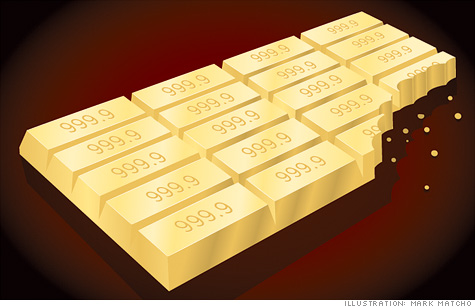Search News

FORTUNE -- With the Federal Reserve pledging to keep interest rates ultralow and geopolitical risk running high, investors seeking inflation hedges continue to pour money into commodities such as gold and oil. And exchange-traded funds, which are highly liquid and easily accessible, are the vehicle of choice. The wildly popular SPDR Gold Trust (GLD), for instance, now holds about $70 billion in assets, making it second in size only to the SPDR S&P 500 (SPY) among ETFs.
But here's the bad news: The tax consequences of owning a commodity-based ETF can be downright nasty. Before diving in, it pays to be aware of the tax pitfalls that await you so that you can minimize the damage.
Commodity ETFs fall into two basic categories, both of which can bite you with unexpected taxes. The first are ETFs that actually hold precious metals, such as the SPDR Gold Trust. When you buy one of these ETFs "the IRS treats you as if you were actually holding the bullion yourself," says Michael Iachini, head of ETF research at Charles Schwab Investment Advisory.
That's not a good thing, because the IRS treats gold, silver, and other precious metals as "collectibles," which don't qualify for the 15% maximum tax rate on long-term capital gains. Instead, gains on precious-metal ETFs that you've held for more than one year are taxed at your ordinary income rate, up to a maximum of 28%. If you hold the ETF for less than a year, gains will be taxed at income rates up to 35%.
The second tax trap lies within ETFs that don't actually hold the physical commodities but use futures contracts to generate their returns. These ETFs -- which include such popular offerings as United States Oil and PowerShares DB Commodity Index Tracking -- are usually structured as limited partnerships. When you sell, 60% of your profits are typically treated as long-term capital gains and taxed at the maximum 15% rate. But the remaining 40% of your gains are automatically deemed short-term -- no matter how long you actually held the ETF -- and taxed at ordinary income rates.
You'll also be on the hook to pay taxes even before you sell. Unrealized gains on these futures-based ETFs are marked-to-market annually; you receive a K-1 form each year outlining your share of those gains, on which you'll have to pay taxes to the IRS.
The easiest way to avoid these headaches is to hold your commodities ETFs inside an IRA. You'll still owe the standard tax on IRA withdrawals at retirement. But until then you can buy and sell the ETFs without triggering any taxes, says Paul Justice, director of ETF research at Morningstar.
You could also consider buying an exchange-traded note that tracks commodities indexes. The tax treatment in regular brokerage accounts is much more favorable: ETN holders owe capital gains taxes only when they sell, and long-term gains qualify for the maximum 15% rate. But you'll need to do more due diligence before you jump in. Commodity ETNs carry credit risk -- if the note's issuer goes bankrupt, you'll be treated as an unsecured creditor and could lose most of your investment. And if that happens, the tax rate won't matter much.

Carlos Rodriguez is trying to rid himself of $15,000 in credit card debt, while paying his mortgage and saving for his son's college education.
| Overnight Avg Rate | Latest | Change | Last Week |
|---|---|---|---|
| 30 yr fixed | 3.80% | 3.88% | |
| 15 yr fixed | 3.20% | 3.23% | |
| 5/1 ARM | 3.84% | 3.88% | |
| 30 yr refi | 3.82% | 3.93% | |
| 15 yr refi | 3.20% | 3.23% |
Today's featured rates: